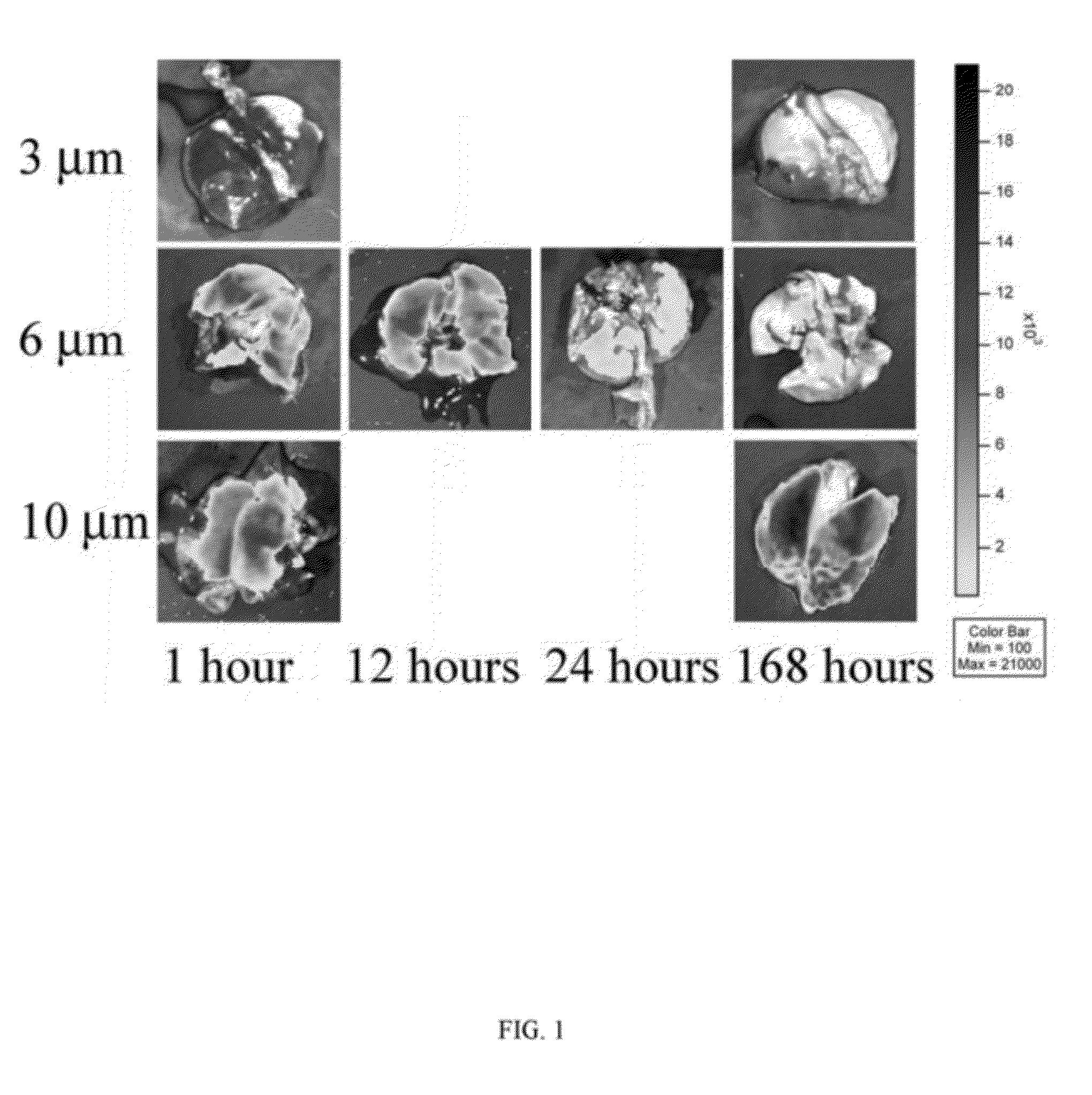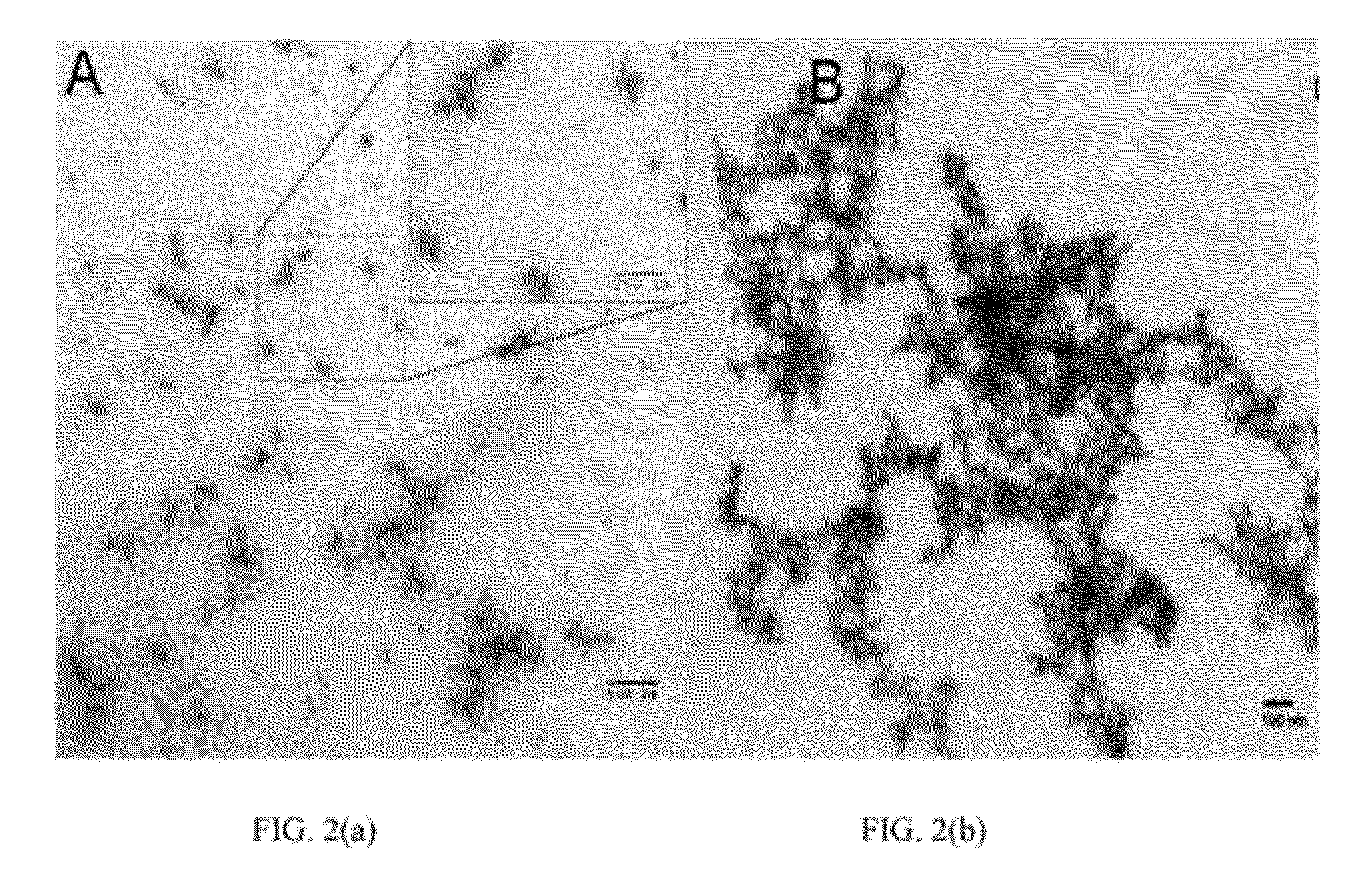Synergistic combinations to reduce particle dose for targeted treatment of cancer and its metastases
a particle and nanoparticle technology, applied in the field of lung targeted nanoparticles, can solve the problems of reducing doses, reducing drug doses in order to boost tissue concentrations, and narrow options for lung targeting, so as to reduce peak systemic drug concentrations, increase anti-cancer drug potency, and reduce drug loading into nps. high
- Summary
- Abstract
- Description
- Claims
- Application Information
AI Technical Summary
Benefits of technology
Problems solved by technology
Method used
Image
Examples
example 1
[0103]PEG nanogels (˜20 nm) were prepared using a 20 kDa 8-arm PEG-SH nanocarrier crosslinked using a HVBS linker at various stoichiometries (1:1, 0.5:1, and 0.8:1). FIG. 2 shows typical TEM images of nanogels (Panel A) and ANPs in the low micron size range (Panel B) that were negatively stained using aqueous solution of 0.5% uranyl acetate. As the ANPs self-assemble, they take on a more flexible spider-like shape similar to that reported for the commercial MAA lung perfusion diagnostic MPs.
[0104]Bio-distribution studies of ANPs covalently labeled with HiLyte750 dye (“DYE-ANPs”) were performed. ANPs of three sizes were prepared (10-30, 30-50 and 50-60 μm). DYE-ANPs were administered (16 mg / kg) to male Sprague-Dawley rats by tail vein injection. Biodistribution of ANPs was determined using IVIS. Peak ANP accumulation was found to occur between 6-12 hr. ANPs were retained in the lungs in high concentrations for 4-5 days with detectable amounts through the 7 days of the study. Larger A...
example 2
Preparation of GMPs by Microfluidics
[0106]The sheath fluid consisted of PDMS (Dow Corning Corporation 749®fluid, Aldrich) containing about 2.0 weight percent initiator (2-Hydroxy-4′-(2-hydroxyethoxy)-2-methylpro-piophenone). For the gel phase, an aqueous solution of 75 percent volume PEG diacrylate macromer (Sartomer, SR259), 0.07 weight percent initiator and 2.0 weight percent SDS was used. 100 nm NPs containing red fluorescent dye (Ciba, Hostasol red) were incorporated (1 NA percent of NPs) to produce the brightly fluorescent about 10 μm droplets as shown in FIG. 7(c). The GMP gel phase encapsulates the NPs containing the fluorescent dye.
[0107]The microfluidic chips were prepared using standard methods of soft lithography. Prior to injection, the micro-fluidic chips were treated with octadecyltrichlorosilane (“OTS”) to make the glass surface hydro-phobic. Flow rates of the oil and aqueous phases were adjusted to achieve a monodisperse sus-pension of water droplets with a diameter ...
example 3
[0109]Size and deformability are the two major determinants of MP passive lung accumulation and retention. To determine that a larger sized deformable GMP has the same lung targeting properties as a smaller rigid MP, at least four GMPs with wide ranging deformabilities using a microfluidic approach are produced. For each type of deformable GMP, a range of sizes are produced. Passive lung targeting is then assessed in normal mice for each GMP type in order to determine the optimal size for a fixed level of deformability. Toxicology and lung function are investigated for the optimally sized GMP at each level of deformability. GMP lung retention time is optimized by engineering the degradation rate of the GMP matrix. As GMPs spontaneously degrade, their size is reduced to a critical value allowing clearance from the lungs.
[0110]The rules learned about optimum GMP size and modulus are the basis for synthesizing PEG macromers with appropriate degradable ester and PLA linkages to tune bot...
PUM
| Property | Measurement | Unit |
|---|---|---|
| Surface | aaaaa | aaaaa |
| Biocompatibility | aaaaa | aaaaa |
| Cytotoxicity | aaaaa | aaaaa |
Abstract
Description
Claims
Application Information
 Login to View More
Login to View More - R&D
- Intellectual Property
- Life Sciences
- Materials
- Tech Scout
- Unparalleled Data Quality
- Higher Quality Content
- 60% Fewer Hallucinations
Browse by: Latest US Patents, China's latest patents, Technical Efficacy Thesaurus, Application Domain, Technology Topic, Popular Technical Reports.
© 2025 PatSnap. All rights reserved.Legal|Privacy policy|Modern Slavery Act Transparency Statement|Sitemap|About US| Contact US: help@patsnap.com



